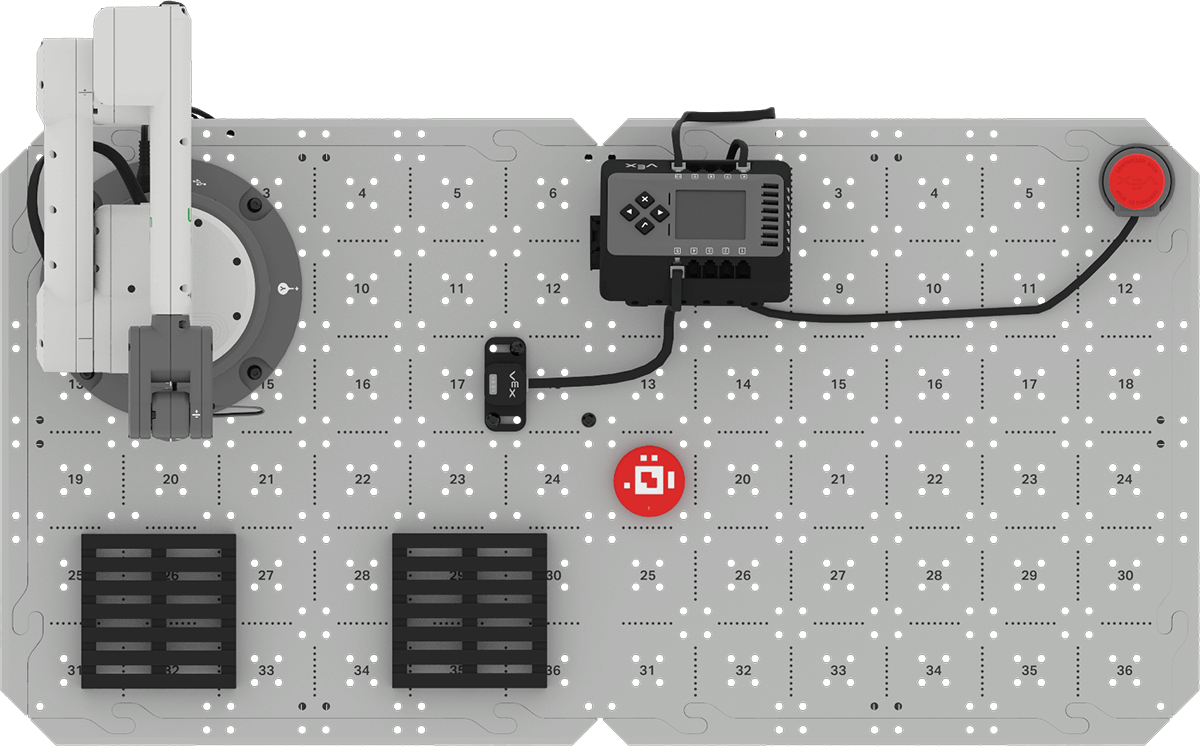Putting It All Together
Previously in this Unit, you learned:
- What an Optical Sensor is, and the data it reports.
- How to optimize decision-making with conditional statements through understanding project flow.
- How to create a VEXcode EXP project to sort Disks by color.
In this Activity, you will create a project to sort six randomly chosen Disks by color onto the correct pallets. This animation below shows the 6-Axis Arm pick up Disks from the loading zone and place them onto the pallet based on their color. Once a Disk has been removed from the loading zone and placed on a pallet, another appears.
Setup: Place one Disk in the loading zone on Brain Tile location 19. Have the other five Disks nearby and ready to place by hand as needed.
 Activity: Create a VEXcode project to sort six Disks by color onto the correct pallets, regardless of the order in which they are placed in the loading zone.
Activity: Create a VEXcode project to sort six Disks by color onto the correct pallets, regardless of the order in which they are placed in the loading zone.
- Plan your project with your group in your engineering notebook. Make a list of each behavior the 6-Axis Arm must complete to sort and move all six Disks to the two pallets correctly.
- Build your project in VEXcode.
- You can either build onto your project from Lesson 3, or create a new project with the Brain CTE 6-Axis Arm Base template. Remember to rename and save your project to your device before you begin editing.
- Run the project to test it. Manually place each Disk at the loading zone once the previous Disk has been picked up.
- Does the 6-Axis Arm successfully sort all six Disks to the correct pallets? If not, continue to edit the project until you have successfully sorted and placed all six Disks. Document any changes to your project in your engineering notebook.
Wrap Up Reflection
Now that you have created a project to sort six Disks by color and place them on the correct pallets, it is time to reflect on what you have learned and done in this Unit.
Rate yourself as a novice, apprentice, or expert on each of the following concepts in your engineering notebook. Provide a brief explanation for why you gave yourself that rating for each concept:
- Identify how the Optical Sensor works, and what data it reports.
- Describe the project flow in a VEXcode project with nested conditional statements.
- Create a project that sorts Disks by color using the Optical Sensor.
Use this table to determine which category you fall under.
| Expert | I feel that I fully understood the concept and could teach this to someone else. |
| Apprentice | I feel that I understood the concept enough to complete the activity. |
| Novice | I feel that I did not understand the concept and do not know how to complete the activity. |
Then, reflect on the learning targets you co-created with your teacher for this Unit. Have you learned what you set out to learn? Why or why not? What were you most successful with? Why? How do you think you can build on your progress moving forward?
Each person in your group should complete their self-reflections in their engineering notebooks. Once everyone in your group has completed their self-reflections, check-in with your teacher and let them know you are ready for your debrief conversation.
Debrief Conversation
Now that you have completed the activities of the Unit, it is time to reflect on your learning and progress throughout the Unit. During this conversation, you and your teacher will discuss your progress towards the learning targets you co-created at the start of the Unit, as well as your self-assessment on the Debrief Conversation Rubric below, and your experience working collaboratively with your group. You will use evidence from your notes and reflections in your engineering notebook to support your ratings and answer questions during the discussion.
Using your reflections and notes in your engineering notebook, rate yourself on the Debrief Conversation Rubric (Google Doc / .docx / .pdf ). For each of the topics, rate yourself as Expert, Apprentice, or Novice.
Ask your instructor if you need any clarification on what is expected of you during this self-assessment.

Select < Return to Units to go back to all Units.